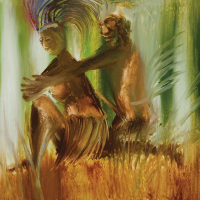55. SIDNEY NOLAN

In a celebrated career that stretched over six decades, Australian artist Sidney Nolan was in seemingly constant motion, traversing the world in search of new subjects and experiences. He was the quintessential travelling artist, famously commenting: Some artists invent their colour relationships and others go in search for them. Im the latter kind.1
Significantly, Nolans comment was made in January 1965 in the New Guinea capital of Port Moresby. Nolan and his wife Cynthia had only recently arrived and were acclimatising to the humidity of the wet season. They were preparing to embark on an odyssey that would take them from Port Moresby to Lae, into the jungle near Mount Hagen and the Wahgi Valley, along the Sepik River, out to Rabaul (a township on the north-west tip of the island of New Britain, about 60 kilometres to the east of the mainland) and back to Port Moresby.
The Nolans travels included walking part of the Kokoda Trail, hazardous plane flights that landed on unmade runways deep in the jungle, fording rivers and trekking through rainforests. It was the sort of adventure that Sidney thrived upon and Cynthia loyally embraced. This trip provided the basis for Cynthias journal, later published as a book, and an interesting series of paintings that Nolan began once he had moved to New York late the same year.
New Guinea is dated in the artists hand as 11 Dec 1965. Like the other major works from the New Guinea series, such as the striking cover illustration of Cynthias book, New Guinea is a large and colourful oil painting that shares an interest in local indigenous people, their customs and elaborate body adornment that was worn during ceremony. It also explores the gratification of an ever-increasing number of (primarily American) adventure tourists.
In the twenty first century we are sensitive to Western ideas about the exotic and otherness, particularly in our attitudes to and representations of people from other lands and cultures. Cynthia Nolan showed in her aptly titled book Paradise, and yet 1971 an awareness of the detrimental effects of Western tourism and the problematic nature of modernisation on under-developed countries such as New Guinea. She desired to experience New Guinean life and give voice to its unique landscape, customs and culture.
We had heard a rumour that dancing was going on somewhere out in the country near Banz, Cynthia Nolan reported. Dutifully she piled into an old jeep with Sidney and they made their way out to where the sing-song was to take place. To the mesmerising sounds of the incessant drum beat, the Nolans were taken by the individual magnificent headdresses like sun-rays spreading from a Hebraic soot-and-pig-fat greased face, six wings of black scalloped with gold, six green wings tipped with red, six black and yellow wings, and nodding, cascading from the crown, twenty-eight of the three-foot long, white, cream, and glossy black feathers of the black bird
of paradise.2
Sidney Nolan captures the forms and colours of the magnificent headdresses and grass and leaf skirts worn by both men and women. He concentrates not on the dance but on couples dispersed from the group, resting and readying themselves for the next performance.3 It is a moment of exhaustion and bliss. Bodies merge seamlessly in tender embrace. In typical Nolan fashion, the scene is conveyed primarily through colour and line. A lime, white and phthalo striped background suggests the veil of the rainforest. Figure and ground are unified through a rainbow coloured headdress and tans, cadmium and burnt umber bodies and grass. The work epitomises Nolans long-held objective to concentrate solely on what was before him to more fully understand and appreciate the whole.
Footnotes
1. Nolan, S., Interview, January 1969
2. Nolan, C., Paradise, and yet, Macmillan, London, 1971, p.92
3. Nolan, C., Op cit, p.94
Rodney James BA (Hons.); MA